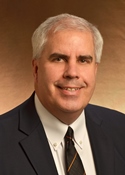Joint Faculty Professor
Biography
Dr. Wereszczak earned his bachelor’s degree in Ceramic Engineering from Alfred University (Alfred, NY) in 1987, and his Ph.D. in Materials Science and Engineering from the University of Delaware in 1992. He presently is a Distinguished R&D Staff Member in ORNL’s Materials Science and Technology Division. He has worked at ORNL in two stints; from 2002 to the present and from 1991 to 2000. He worked at the US Army Research Laboratory from 2000-2002. Most of his professional career has been devoted to the characterization and modeling of the relationship between mechanical response of brittle materials and their microstructure. His work has contributed to the development of diverse sets of ceramics and other brittle materials considered for use in components for advanced gas turbine engines, internal combustion engines, glass manufacturing furnaces, armor, hybrid bearings, gun barrel liners, thermoelectric devices, power electronic devices, and photovoltaic cells. He has authored or co-authored over 175 publications including three book chapters, several patents and pending invention disclosures, has a copyrighted software program developed for microstructural-level thermomechanical modeling to his credit, has given over 100 presentations, and presently is an Associate Editor of the International Journal of Applied Glass Science. Dr. Wereszczak became a Joint Faculty Professor in early 2014.
Research
- Science and engineering of brittle materials
- Brittle materials used in armor, internal combustion engines, gas turbine engines, filtration, high-temperature processing, thermoelectric devices, electronic devices, actuators, rolling contact and wear applications, consumer items, and nuclear applications.
- Micro-, meso-, and macro-mechanical response as a function of material microstructure
- Mechanical reliability and thermal management of structures
- Novel mechanical test methods
- High-temperature mechanical test methods
- Probabilistic life prediction and design of brittle components
- Fracture mechanics and finite element analysis
Education
Ph.D., Delaware: Mechanical Behavior, Science and Engineering of Ceramics, Glasses,and Brittle Materials
Professional Service
- American Ceramic Society (ACerS): Engineering Ceramics Division, Glass and Optical Materials Division
- American Society for Testing and Materials (ASTM): C-28 Advanced Ceramics
- Institute of Electrical and Electronics Engineers (IEEE), Senior Member: Components, Packaging, and Manufacturing Technology Society
Awards and Recognitions
2011 Fellow, American Ceramic Society
2009 Distinguished R&D Staff Member, Oak Ridge National Laboratory
2009 Chair, ACerS’s Engineering Ceramics Division
2008 Program Chair, International Conference on Advanced Ceramics and Composites
2008 ACerS’s Richard M. Fulrath Award
Publications
- A. Wereszczak, O. Jadaan, M. Modugno, G. Hatala, and M. Lance, ” Adaptation of the Chevron-Notch Beam Fracture Toughness Method to Specimens Harvested From Diesel Particulate Filters,” in International Journal of Applied Ceramic Technology, 00:1-9 (2017). doi:10.1111/ijac.12653.
- A. A. Wereszczak, J. E. Cousineau, K. Bennion, H. Wang, R. H. Wiles, T. B. Burress, and T. Wu, “Anisotropic Thermal Response of Packed Copper Wire,” in press, Journal of Thermal Science and Engineering Applications, (2017).
- K. J. Ham, Y. K. Vohra, Y. Kono, A. A. Wereszczak, and P. Patel, “White-Beam X-ray Diffraction and Radiography Studies on High-Boron Containing Borosilicate Glass at High Pressures,” High Pressure Research, (2017). doi.org/10.1080/08957959.2017.1287263
- A. Wereszczak, S. B. Waters, R. J. Parten, and L. D. Pye, “Sub-Micron Fracture Mechanism in Silica-Based Glasses Activated by Permanent Densification from High-Strain Loading,” Journal Non-Crystalline Solids, 443:172-183 (2016).
- A. Wereszczakvand C. E. Anderson, Jr., “Borofloat and Starphire: A Comparison,”Int. J. Applied Glass Sci., 5:334-344 (2014).
- A. Wereszczak, M. K. Ferber and W. Musselwhite, “Method for Identifying and Mapping Flaw Size Distributions on Glass Surfaces for Predicting Mechanical Response,” Int. J. Applied Glass Sci., 5:16-21(2014).
- A. Wereszczak, E. E Fox, M. J. Lance, and M. K. Ferber, “Failure Stress and Apparent Elastic Modulus of Diesel Particulate Filter Ceramics,” SAE Int. J. Mater. Manuf.,5:517-527 (2012).
- A. Wereszczak, D. J. Vuono, Z. Liang, and E. E. Fox, “Sintered Silver Joint Strength Dependence on Substrate Topography and Attachment Pad Geometry,” 7th International Conference on Integrated Power Electronics Systems (CIPS), Nuremberg, Germany, Mar. 2012.
- A. Wereszczak, W. L. Daloz, K. T. Strong, Jr., and O. M. Jadaan, “Effect of Indenter Elastic Modulus on Hertzian Ring Crack Initiation in Silicon Carbide,” Int. J. of Applied Cer. Tech., 8:885-894 (2011).
- A. Wereszczak, T. P. Kirkland, M. E. Ragan, K. T. Strong, Jr., and P. Patel, “Size-Scaling of Tensile Failure Stress in a Float Soda-Lime Silicate Glass,” Int. J. Applied Glass Sci.,1:143-150 (2010).
- A. Wereszczak, M. E. Ragan, K. T. Strong, Jr., P. J. Ritt, H. Wang, J. R. Salvador, and J. Yang, “Strength of N- and P-Type Skutterudites,” Cer. Eng. Sci. Proc.,31, [9] 49-60 (2010).
- A. Wereszczak, D. C. Harper, C. E. Duty, and P. Patel, “Glass Strengthening via High-Intensity Plasma-Arc Heating,” J. Am. Cer. Soc., 93:1256-59 (2010).
- A. Wereszczak, K. E. Johanns, and O. M. Jadaan, “Hertzian Ring Crack Initiation in Hot-Pressed Silicon Carbide,” J. Am. Cer. Soc.,92:1788-1796 (2009).
